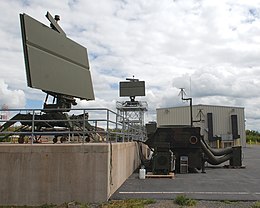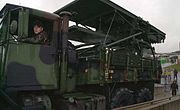| Revision as of 00:15, 6 January 2015 editDPdH (talk | contribs)Extended confirmed users31,295 edits →Description: Added "footnote" about meaning of "TPS" acronym, with source citation.← Previous edit | Revision as of 00:17, 6 January 2015 edit undoDPdH (talk | contribs)Extended confirmed users31,295 edits →Footnotes: Added section "References" with sub-sections.Next edit → | ||
| Line 23: | Line 23: | ||
| == Footnotes == | == Footnotes == | ||
| {{reflist|group=n}} | {{reflist|group=n}} | ||
| == References == | |||
| === Notes === | |||
| {{reflist}} | |||
| === Sources === | |||
| {{empty section|date=January 2015}} | |||
| ==See also== | ==See also== | ||
Revision as of 00:17, 6 January 2015
| This article does not cite any sources. Please help improve this article by adding citations to reliable sources. Unsourced material may be challenged and removed. Find sources: "AN/TPS-75" – news · newspapers · books · scholar · JSTOR (July 2010) (Learn how and when to remove this message) |

The AN/TPS-75 is a transportable 3-dimensional passive electronically scanned array air search radar produced in the United States. It was originally designated the TPS-43E2. Although the antenna is a radically new design from the TPS-43, the radar van itself, which houses the transmitter, receiver processors, and displays is very similar to the older TPS-43E2. It is produced in the United States originally by Westinghouse Defense and Electronic Division, which was later purchased by Northrop-Grumman.
Description

The AN/TPS-75 is the primary transportable Aerospace Control And Warning (AC&W) radar used by the United States Air Force. The TPS-75 is capable of transmitting 5-Megawatts of power. (Although 5-Megawatts is almost never achieved; realistically it is approx 2.8 Megawatts)
The entire system can be broken down and packed onto two M939 trucks for road transport and mobile air transport by planes such as the C-130 Hercules or bigger. The entire radar system can be "torn down" and ready for transport in just a few hours. This varies greatly with amount of personnel, their level of training and motivation, and methodology of transport. A typical convoy package would consist of one 5-ton truck pulling the radar van itself with the radar antenna in the bed of the truck and a support 5-ton pulling an AN/MJQ-1632 400 Hz power plant. The support truck would hold some spare parts, fuel tank(s), camouflage netting, and other logistical items as needed. The heat exchanger and -18 environmental control unit (ECU) are normally loaded into and transported within the radar van.
There are many add-ons for the TPS-75. One of which allows the AN/TPS-75 to be tilted back to see into the atmosphere assisting in detection of long range ballistic missiles.
Specifications
- Frequency Range 2.9 - 3.1 GHz (S-Band)
- Peak Power: 2.8MW nominal
- Pulse Width: 6.8μs
- Range: 240nmi
- Power Requirements: 120/208 VAC, 3 Ph, 400 Hz
- Power Consumption: 52 Kilowatts
Footnotes
- The US Military description for radar type TPS is "Ground, Transportable; Radar; Detecting, Range and Bearing, Search".
References
Notes
- Mobile Military Radar website, Radar Types page (accessed 2015-01-06)
Sources
| This section is empty. You can help by adding to it. (January 2015) |
See also
Further reading
- Mobile Military Radar website, Radar Description page - TPS-75 description & specifications (accessed 2015-01-06)